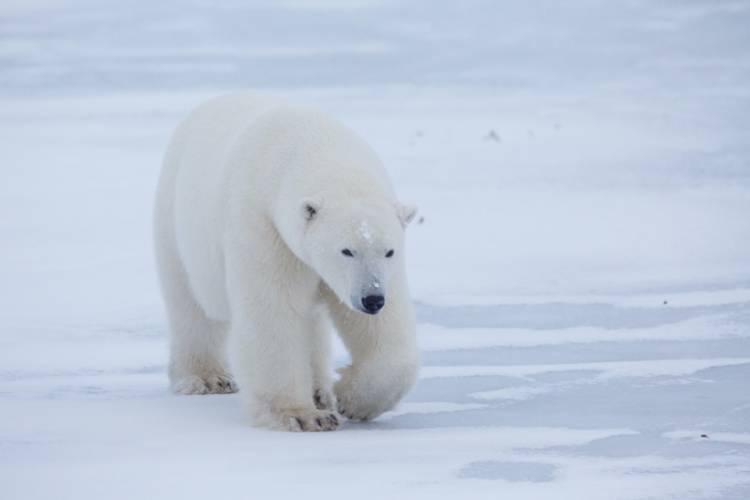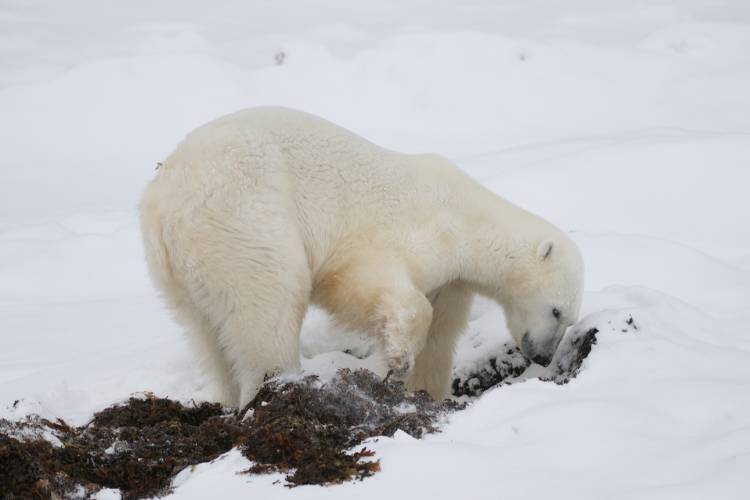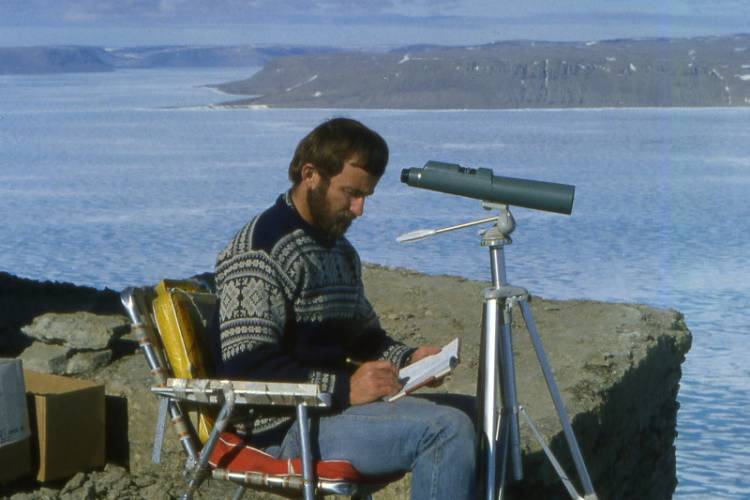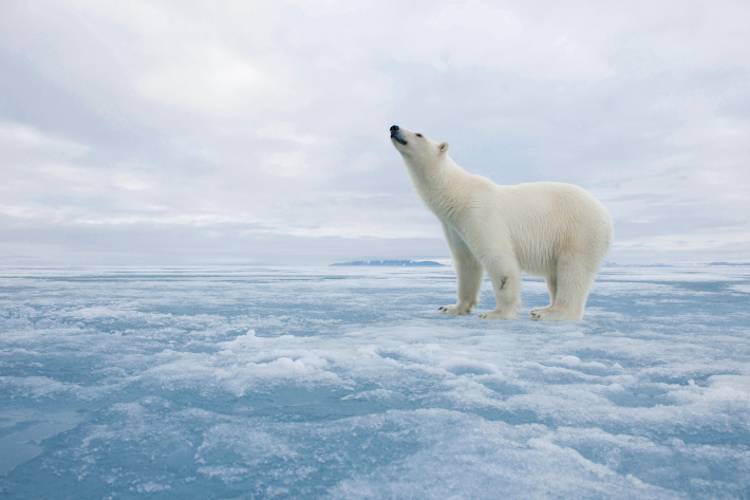Photo: Kt Miller / Polar Bears International
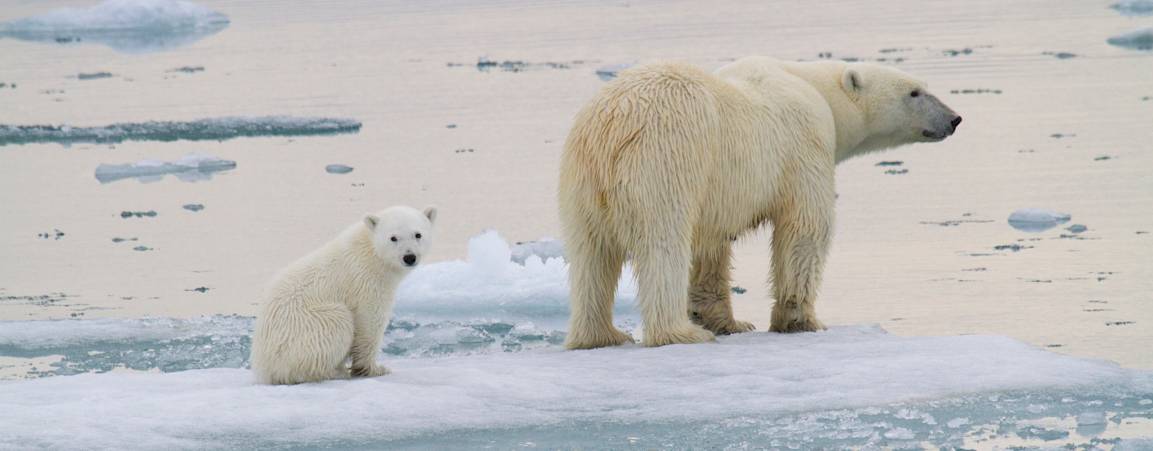
New Paper Provides Climate Policy Framework
A landmark new paper from our chief scientist emeritus addresses a loophole in the Endangered Species Act, paving the way for removing the current roadblock to polar bear protections.
Background
In 2008, Polar Bears International’s chief scientist emeritus, Dr. Steven Amstrup, then with the USGS, spearheaded the team that led to the polar bears’ listing as a threatened species under the Endangered Species Act due to sea ice loss from climate change.
However, the Solicitor of the Interior at the time, David Bernhardt, issued a memo stating that the impact of greenhouse gas emissions on polar bears could not be considered when evaluating new projects, like oil and gas wells, because “It is currently beyond the scope of existing science to identify a specific source of C02 emissions and designate it as the cause of specific climate impacts at an exact location.”
This created a loophole that prevented the government from considering climate impacts on polar bears.
Dr. Amstrup has just published a paper, coauthored by Dr. Cecilia Bitz, showing that scientists can now calculate the impacts of greenhouse gas emissions from a specific project on the number of ice-free days in the Arctic. They can also show the impact of a specific number of ice-free days on polar bear survival rates—thus closing the loophole in the Bernhardt Memo.
When a species is listed under the Endangered Species Act, the government is required to use “the best available science” to inform a species recovery plan. This new paper should allow regulators to rescind the Bernhardt Memo and address emissions under the Endangered Species Act.


“I consider this the most important paper of my career. It helps explain recently observed population trends, overcomes a stumbling block in U.S. policy, and can inform other countries considering development projects—finally giving polar bears the protection they need.”
— Dr. Steven Amstrup
The Big Picture
We can now link specific quantities of emissions to the resulting number of ice-free days in the Arctic.
Each additional ice-free day can then be linked to a specific decline in polar bear cub survival rates.
The largest threat to polar bears from climate change is low cub recruitment—or too few cubs surviving to adulthood, or being "recruited" into the next generation.
Recruitment is impacted by sea ice loss as mothers have less opportunity to hunt for their main prey, seals, straining the limits of their fat reserves.
The Impact
Because of this paper, the “best scientific data” now provides a way of measuring the impacts of a single project on polar bear survival—thus closing the loophole in the Endangered Species Act created by the Bernhardt Memo, which dates back to the George W. Bush administration and is still in place today.
The approach used in the paper can also be applied to other species impacted by climate change, and it can serve as a model for other countries weighing development impacts.

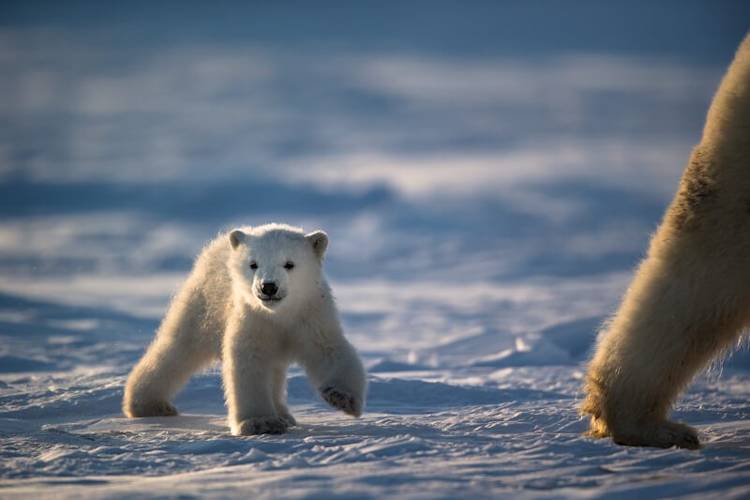
Photo: Meril Darees / Polar Bears International
Get Involved
Based on the best available science, the research shows that we should rescind the Bernhardt Memo and give polar bears the protection they deserve. Sign up for our email list for ways to add your voice to others speaking up on behalf of the bears, ensuring that these findings result in policy changes that protect polar bears and help all of us.
Why Do Polar Bears Need Sea Ice?
For polar bears, home is on the Arctic sea ice. They rely on sea ice hunt, breed, roam, and sometimes to den. Learn more about Arctic sea ice and its importance to polar bear survival.
Timeline of Polar Bear Research & U.S. Policy
Since the polar bear was listed under the Endangered Species Act, scientists around the world have been hard at work on research linking specific quantities of emissions to sea ice loss and lower polar bear survival rates. Take a look at the advances that have led to the latest paper from Amstrup and Bitz, set alongside a policy timeline.

December 15, 2005 — Conservationists file lawsuit to protect polar bears under Endangered Species Act (ESA)
Center for Biological Diversity
2007 — USGS team tasked with researching whether polar bear listing is merited
Steven Amstrup is team leader
May 14, 2008 — Internal memo at U.S. Department of the Interior decides that the impact of emissions are “beyond the scope of existing science”
U.S. DOI memo #2008438-D0
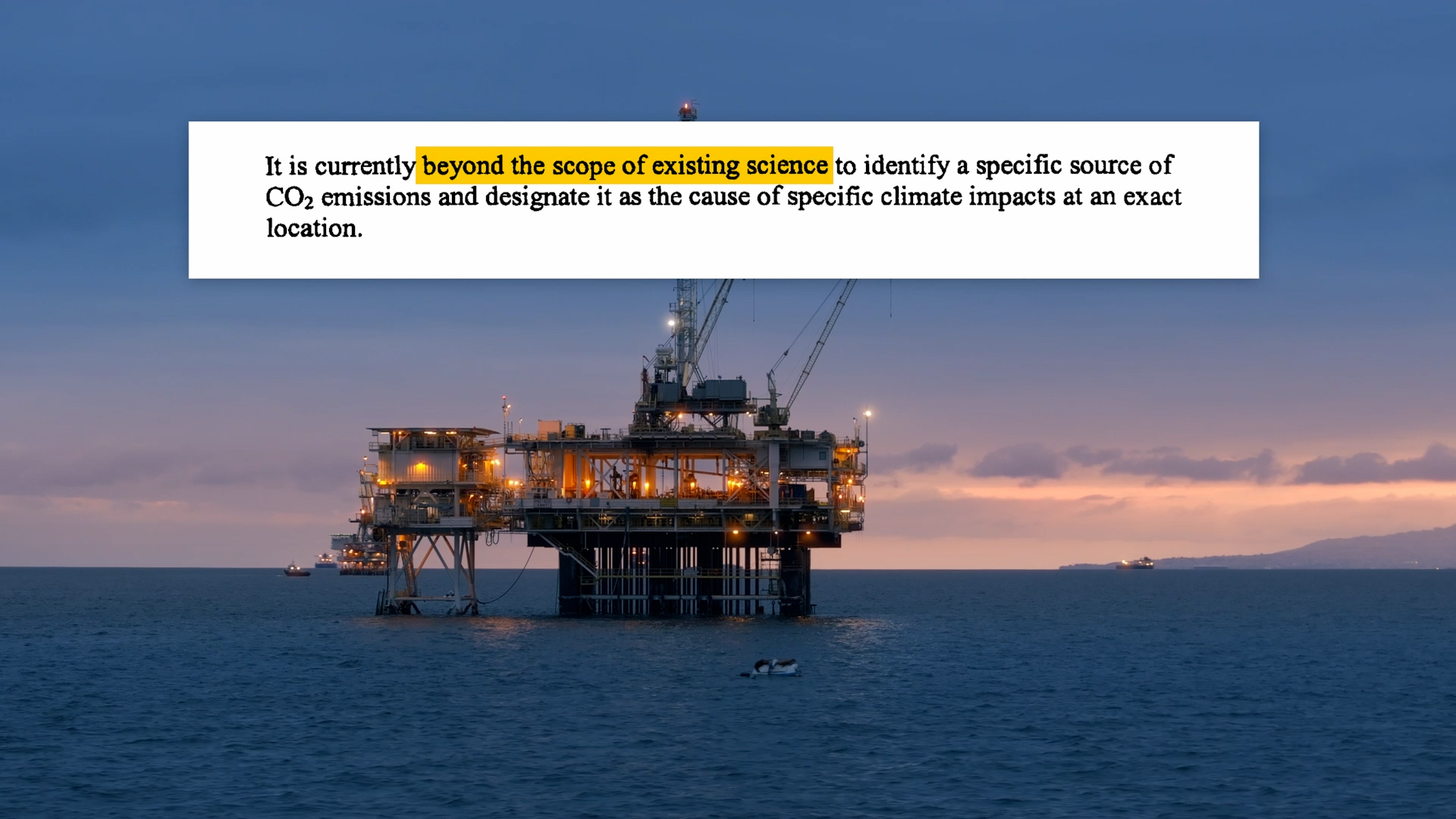
May 15, 2008 — Determination of Threatened Status of the Polar Bear (Ursus maritimus) Throughout Its Range
U.S. lists the polar bear under the ESA
October 3, 2008 — “Bernhardt Memo” M37017 issued
Citing data gaps, memo blocks ESA from considering impact of emissions on polar bears
December 16, 2010 — Study shows sea ice can recover if emissions are addressed
Steven Amstrup et al (Nature)
May 29, 2012 — Study confirms impacts of sea ice loss on polar bears
Ian Stirling et al (Global Change Biology)
December 10, 2013 — U.S. Fish and Wildlife Service (USFWS) convenes Polar Bear Recovery Team
Tasked with writing Polar Bear Conservation Management Plan
July 17, 2015 — Study finds polar bears unable to adaptively fast in summer
John Whiteman et al (Science)
October 13, 2015 — USFWS initiates 1st status review for polar bears
Conducted every 5 years for ESA-listed species
September/October 2016 — Study shows polar bears lose roughly 1 kg per day when fasting in summer
Nick Pilfold et al (Physiol. Biochem.)
November 3, 2016 — Study links emissions to sea ice loss
Notz, Stroeve (Science)
January 9, 2017 — U.S. Polar Bear Conservation Management Plan
Plan is issued and calls for global reduction in emissions, but offers no concrete plan for doing so

December 1, 2017 — Study finds polar bears are food deprived on sea ice that has retreated far north in summer
John Whiteman et al (Oecologia)
May 15, 2018 — 10th anniversary of polar bears’ ESA listing
ESA still prevented from considering emissions
July 20, 2020 — Study establishes fasting thresholds for polar bears; links number of summer ice-free days to polar bear survival rates
Molnar et al (Nature Climate Change)
October 5, 2021 — USFWS initiates 2nd status review for polar bears
Conducted every 5 years for ESA-listed species
August 31, 2023 — Unlock the Endangered Species Act to address GHG emissions
Pulls together data on emissions, sea ice loss, and polar bear survival to overcome restrictions in the Bernhardt Memo; approach accurately reproduces recent population declines in Western Hudson Bay
Amstrup and Bitz (Science)
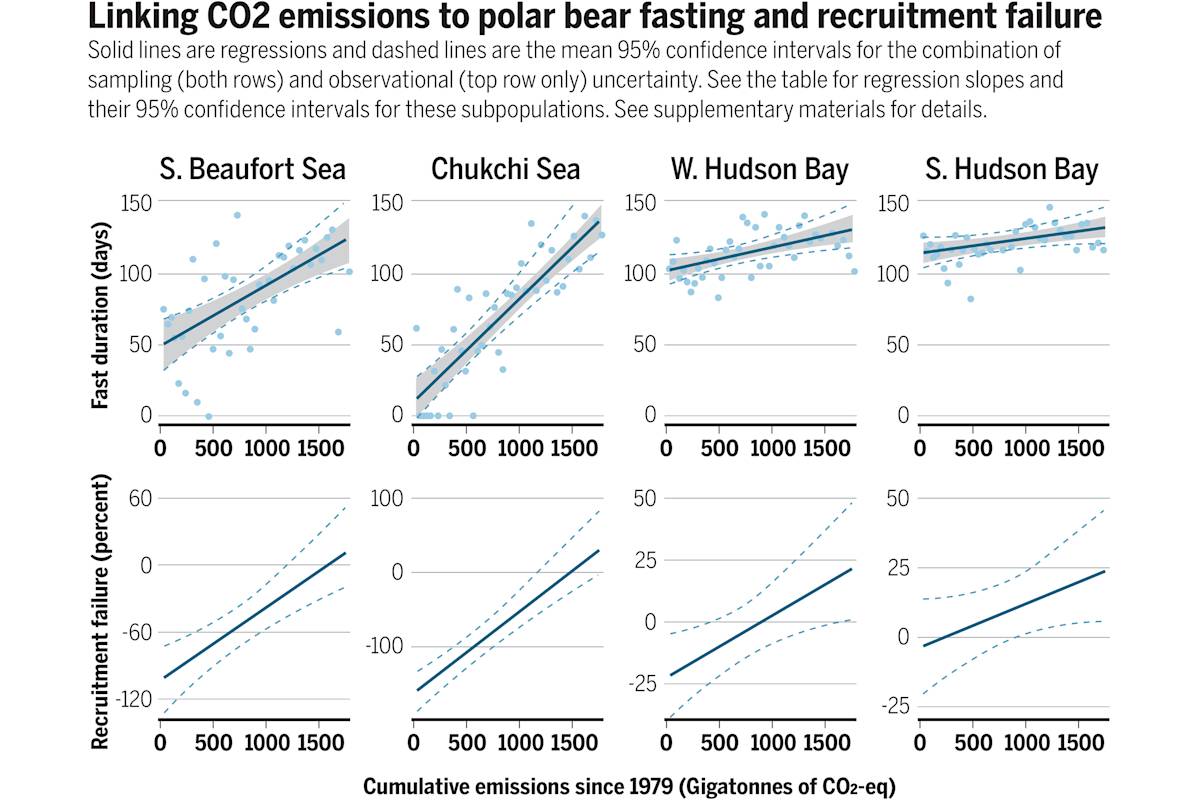
Used with permission from Amstrup and Bitz, Science, 10.1126/science.adh2280 (2023).
Next steps — Rescind the Bernhardt Memo and give polar bears the protection they deserve, based on the best available science

